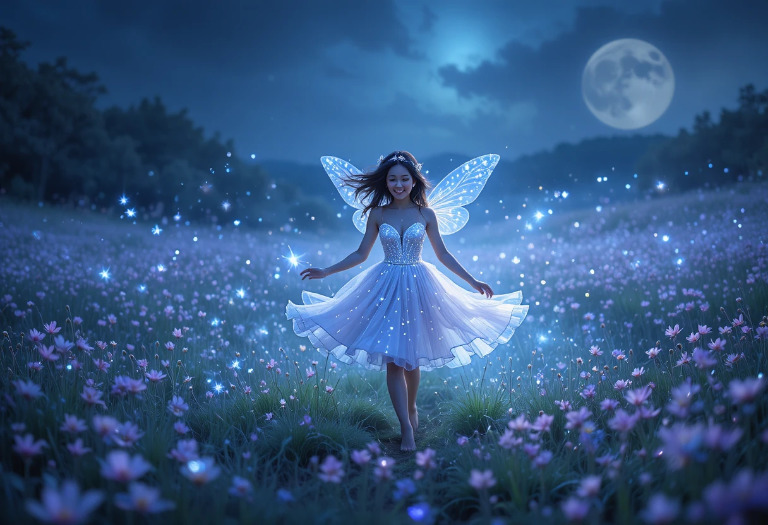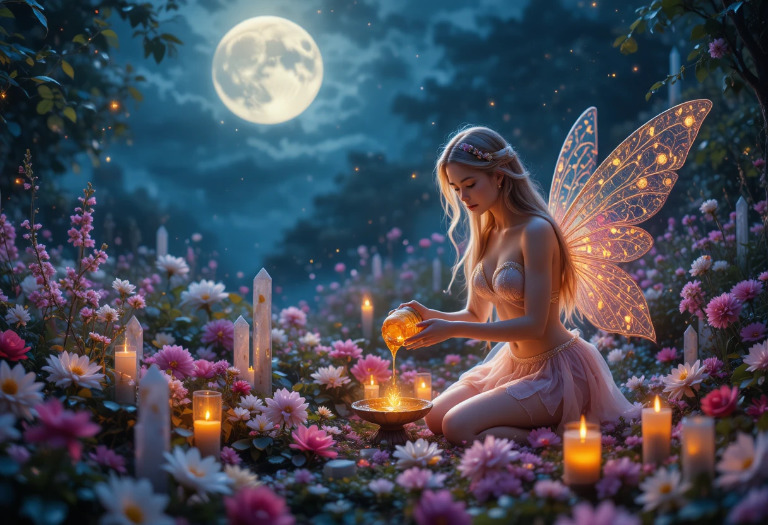
If you’ve ever felt a shimmer in the air when the wind moves through trees, or caught a flicker of light that disappeared the moment you turned—there’s a chance you’ve brushed against fairy magic. Fairies are masters of quiet mysteries, hidden between the folds of our world. They live in whispers, laughter, and wildflowers, and they’re closer than most people ever realize. The secret is—they’re always watching, always weaving their little enchantments where nature still breathes freely.
Fairies have never been just pretty creatures from bedtime stories. In truth, they’re ancient spirits of nature—keepers of energy, memory, and balance. They live in places untouched by steel or noise: mossy groves, wild gardens, misty lakes, and moonlit paths. They remember a time before humans forgot how to listen. When you stop and feel the stillness, that’s when they lean in the closest. They don’t speak like we do. They speak through signs—fluttering leaves, sudden chills, or little things that go missing with no explanation.
But fairies aren’t all sweetness and sparkle. Like any beings of power, they have moods and rules. They can be kind, but they can also be mischievous or even territorial. They’re nature spirits, and nature itself is both gentle and fierce. If you want to know them, you must respect them. Approach their world like you would a sleeping forest—slowly, humbly, and with open eyes.
So, let’s wander quietly now—through mushroom rings, dewdrops, and forgotten corners of gardens—and uncover what really goes on in the secret life of fairies.
The Secret Life of Fairies
The Hidden Realms They Call Home

Fairies exist in places where magic still hums beneath the soil. They live in what some call the Otherworld, a realm layered over our own. To us, it’s invisible—thin as a veil—but to them, it’s bursting with color and sound. Every forest, every meadow, every running stream has its own fairy presence. The shimmer of sunlight through leaves, the hum of bees, even the pattern of raindrops on stone—all of it is their language, their home.
Their villages are woven from things we overlook: flower petals, spider silk, polished seeds, and moonlight. They build with care, often inside hollow trees or under hills where roots curl like protective arms. Some fairies live by water, tending reeds and lilypads, while others prefer mountaintops, dancing in lightning storms. It’s believed each natural element has its own fairy kind—earth, air, fire, and water—and their energy flows through those spaces like veins of light.
When you step into the woods at dusk, you might feel that sudden awareness that you’re being watched—but not in a frightening way. It’s their curiosity. Fairies often study humans who wander too close to their dwellings. Some even follow you home, especially if they sense kindness or a spark of belief. They love people who still believe.
What Fairies Do When You’re Not Looking

While we sleep or rush through our busy lives, fairies are working in the quiet. They tend to the unseen threads that hold nature together. They help plants grow, pollinate flowers, and keep balance in places where energy feels off. When a space feels peaceful or “alive,” that’s often fairy influence. They’re not doing it for us—they do it because it’s their purpose. They’re caretakers, not servants.
Fairies also have a deep love for music and laughter. It’s said they gather at night to dance in circles of moonlight, their songs echoing faintly as the wind. The dew you find in the morning? Some say it’s the shimmer left behind after their celebrations. They also love playing tricks, especially on those who mock nature or steal from it without asking. Missing keys, tangled hair, spoiled milk—those are classic signs of fairy mischief.
When the seasons change, fairies work harder than ever. They guide plants to sleep in autumn, weave frost patterns in winter, and wake blossoms in spring. You might notice little bursts of life—flowers growing overnight, mushrooms appearing suddenly, or a single patch of grass glowing greener than the rest. That’s their touch.
Fairy Types and Their Curious Personalities

Not all fairies are the same. Some are light-hearted and friendly, while others are ancient and solemn. Woodland fairies are the most commonly seen—they love trees, mushrooms, and small creatures. Water fairies dwell in ponds and rivers; they’re dreamy, emotional, and protective. Air fairies are quick and unpredictable, like a breeze that shifts directions. And fire fairies? Rare, radiant, and a little wild—they thrive in volcanoes, deserts, or even candle flames.
Then there are household fairies, often called brownies or house sprites. They live quietly in human homes, helping with small chores if they’re treated kindly. Leave them a bit of milk or honey, and they might bless your house with calm and good luck. But if you forget your manners, they might turn mischievous, hiding things or stirring up tension.
The fae courts—Seelie and Unseelie—are another layer of their world. The Seelie Court is full of playful, benevolent fairies who enjoy dancing, music, and bringing joy. The Unseelie Court is wilder—darker fairies who embrace the chaotic side of nature. Neither is purely good or evil; they both keep the balance. Just as day needs night, light needs shadow.
Signs a Fairy Is Nearby

Fairy presence can be subtle, but once you learn to notice, you’ll see it everywhere. The most common sign is flickering lights—tiny orbs that dance at the edge of your vision. Some call them will-o’-the-wisps. Others feel a sudden cool breeze indoors, a floral scent with no source, or hear faint chimes when there’s no wind. Animals are often the first to notice them—cats staring at empty corners, dogs wagging at the air.
Losing small objects is another clue. Fairies love shiny things—buttons, jewelry, coins—and they’ll often “borrow” them. If something goes missing and turns up days later in a strange spot, that’s classic fairy behavior. You might also feel drawn to certain outdoor places that feel oddly peaceful or alive, like the air itself is humming. That’s where fairy energy lingers strongest.
Sometimes fairies appear in dreams, especially when they’re trying to communicate. You might dream of forests, glowing lights, or hearing music that makes you feel both homesick and enchanted. When you wake up feeling lighter or inspired to create something, it’s a good sign they visited.
How to Invite Fairy Energy Into Your Life

Fairies are naturally drawn to kindness and creativity. If you want to welcome them, start with respect. Never demand their presence—invite it. Keep your space clean, honor nature, and leave small offerings. Fresh flowers, shiny coins, milk, or honey work beautifully. You can set them outside under the moon or on a small fairy altar. Always say thank you, even if you don’t see them.
Planting wildflowers or herbs like lavender, thyme, and foxglove can attract fairy energy. They love gardens that buzz with life. Bells, wind chimes, and crystals also help, as fairies enjoy light and gentle sound. Try spending quiet time outdoors—sit barefoot on the grass, listen, and let your thoughts soften. That’s when they’re most likely to appear.
Art, music, and laughter also draw them in. Fairies adore beauty and joy. When you create something purely for fun, you’re aligning with their energy. So sing, paint, dance, write poetry—whatever makes your spirit feel light. It’s one of the best ways to become “fairy-favored.”
The Rules of Fairy Etiquette

If you do attract fairies, there are a few important rules to follow. Never boast about them or try to show them off—they dislike arrogance. Don’t take things from their spaces, like stones from a fairy ring or flowers from a wild patch, unless you’ve asked permission first. Fairies see that as theft, and they can be quick to teach lessons through mischief or bad luck.
Always keep promises. If you offer something, follow through. Fairies value truth and intention more than grand gestures. If you ever feel you’ve offended them, apologize sincerely and leave a small offering as peace. They understand humility and will often forgive quickly.
And finally—don’t try to trap or command a fairy. They are ancient, powerful beings, not toys or pets. Their trust must be earned, never forced. Treat them as equals, and you may find your world lighting up in ways you never imagined.
When Fairy Magic Touches Your Life

Fairy magic is subtle but transformative. You might notice a sense of calm in your home, sudden bursts of luck, or even quicker plant growth. Sometimes, they help you see beauty again—make you notice tiny details you’d been too busy to see. They awaken the wonder we lose as adults, the childlike belief that magic is real because it is.
Their influence can also be protective. Some people feel a soft pull away from danger, like intuition whispering “not this way.” Others experience healing through nature—sitting by trees or near water feels strangely recharging. That’s fairy energy, quietly mending what’s tired in your spirit.
If you ever feel stuck or heavy, spend time outside and ask (nicely) for a sign. You might find a feather, a perfect clover, or hear laughter on the wind. It’s their way of saying, we see you.
When You Remember Magic

Fairies remind us that magic was never meant to be rare—it’s just hidden beneath distraction. When you slow down, listen to the rustle of leaves, or smile at a dragonfly hovering nearby, you’re tuning back into their world. They thrive on wonder, and they love when humans remember how to wonder, too.
Maybe fairies aren’t just tiny winged beings. Maybe they’re the living breath of the Earth itself—curious, playful, and wild. When you live gently, laugh often, and care for what’s alive, you become part of their story. And in that quiet connection, you realize the truth: fairies were never gone. You just needed to remember how to see them.




